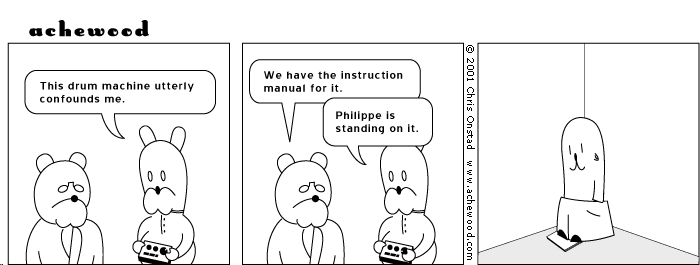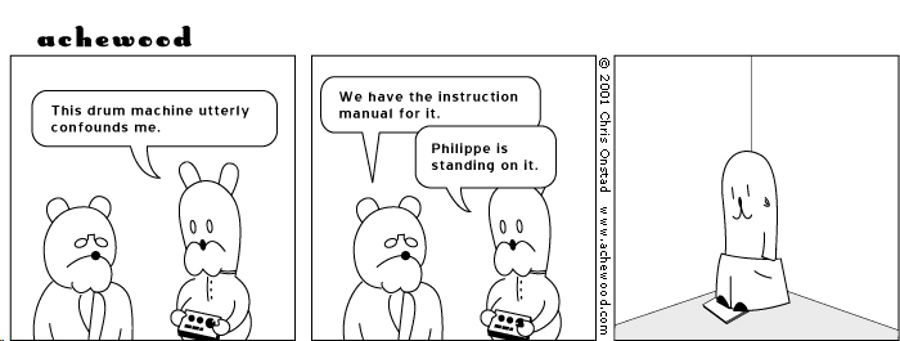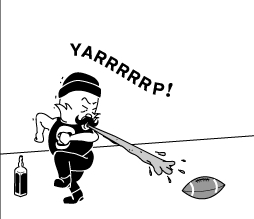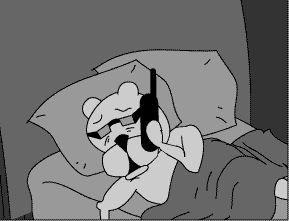Archive Binge: Achewood
When I moved up to Seattle in 2007, my new housemates gave me one of the weirder ultimatums I’ve ever experienced. “You can stay here until you find a place,” they told me, “But you have to read this webcomic. If you’re going to live here, you have to read this webcomic. Trust us.” So I opened up Achewood dot com, went back to the very first strip, and read, uh, this.
But hey, I was unemployed, so I had plenty of time to archive binge, and just kept going.The result, years later, is that I saw this a few weeks ago and just about exploded, because Achewood is one of the funniest creative endeavors I’ve ever experienced. It’s complex, bizarre, occasionally baffling, and for the past couple years it’s been essentially moribund as creator Chris Onstad attempts to recharge his creative batteries – and with all that, it still permeates my daily speech patterns like no other entertainment I can remember.
Besides the fake etymology, “Achewood” is a pun on Winnie the Pooh’s Hundred Acre Wood, and that’s probably the best way to describe the comic – Pooh & co. absolutely tripping balls. There’s a society of talking animals and the occasional robot, and they live underground from us, and have their own hip-hop labels and Subway franchises. The internal logic wisely operates off of Rule of Funny, so Oasis and Emeril Lagasse exist but humanity as a whole is not really relevant unless there’s a good joke to be plumbed from it.
What Achewood presents is the perfect kind of self-contained comedy franchise, where the universal jokes carry you until you’re invested in the character-based humor, all accomplished by some of the best dialogue I have ever encountered, so even run-of-the-mill gags get a boost and really good bits just take off into flight. You’ll occasionally run into something sounding forced (particularly later strips during the down period), but by and large, the characters’ unique voices all sound convincing.
And oh, what characters they are! The early House Party arc was where they first started to take off, and also where the strip’s unofficial mascot, morose programmer cat Roast Beef Kazenzakis, got his introduction. Beef is the Guy Who Sucks (Plus He’s Got Depression) and a lot of the strip’s glory period rotates around his darkly humorous struggle with his condition, and his lifelong friendship with Ray Smuckles, an affable blowhard who can’t trip on the sidewalk without falling next to a fifty-dollar bill. They’re backed by an ensemble cast that includes a distinguished old bear who churns out hack romance novels by the pound, an otter who is permanently five years old, an excruciatingly polite serial killer, and Lyle.
On the art side, Onstad evolved into a master of doing a lot with a little. While there’s obvious art evolution and improvement, the basic style of the strip has never changed, and that minimalism adds something to the surreal humor. There’s also a lot to be said for the power of working with funny talking animals; he can rearrange their expressions as needed to convey things that might just be impossible with human caricatures.
Achewood’s greatest success up ‘til now was probably the publication of the Great Outdoor Fight hardbound, a chronicle of a web arc that followed Ray & Roast Beef’s misadventures in the ultimate test of badassitude. While probably the highlight of the strip’s run, it also serves as an example of Achewood’s greatest weakness – it’s, well, pretty bro-tastic. Some of Onstad’s favorite topics are the powerful bonds of brotherhood and the silly demands of machismo, and while I enjoy the shit out of his take on both of them, the cast is a sausage fest with only a couple significant female characters. If you can get past that hurdle, the GOF is a great place to start if you want a sample of what Achewood is like at its best.
It’s also illustrative of the strip’s insane fan following; in the wake of publication, we Acheheads created a wiki for the Great Outdoor Fight and populated it with an entire chronicle of the Fight’s history, traditions, and controversies. Fandoms gonna fan, of course, but something about the GoF just struck a primal chord of creativity. Things like that make me resoundingly optimistic about the prospects of an Achewood animated series. It’s weird, and surreal, and takes some investment, but good god damn when Achewood is right it is funnier than just about anything out there. Funny in the way that makes you laugh till you’re weeping, and keep it in your mental quote-box for years afterwards; funny in the way that’s just true enough. Give it a read, and trust me, if that animated series happens, you’ll be hearing a lot more about it.








